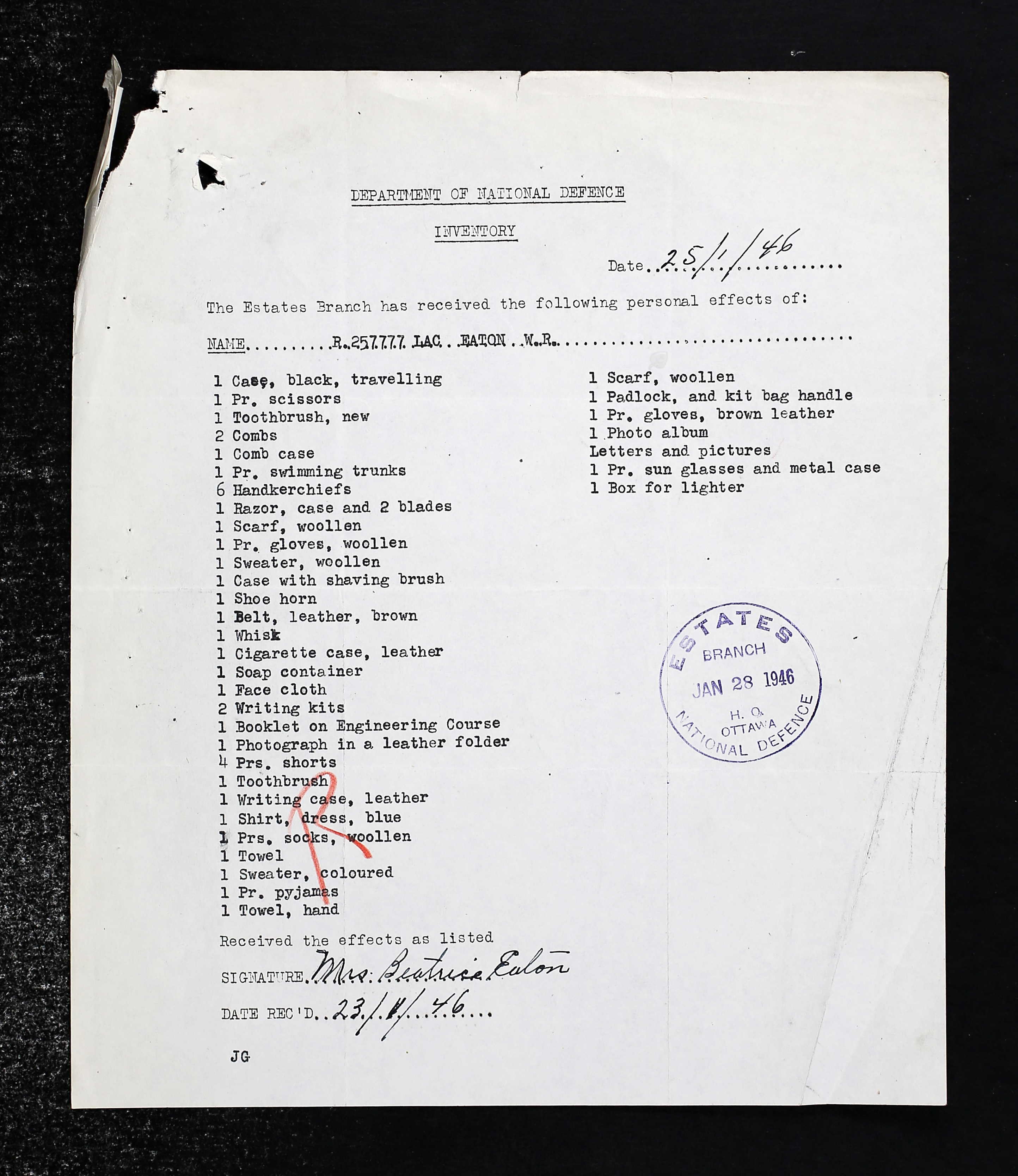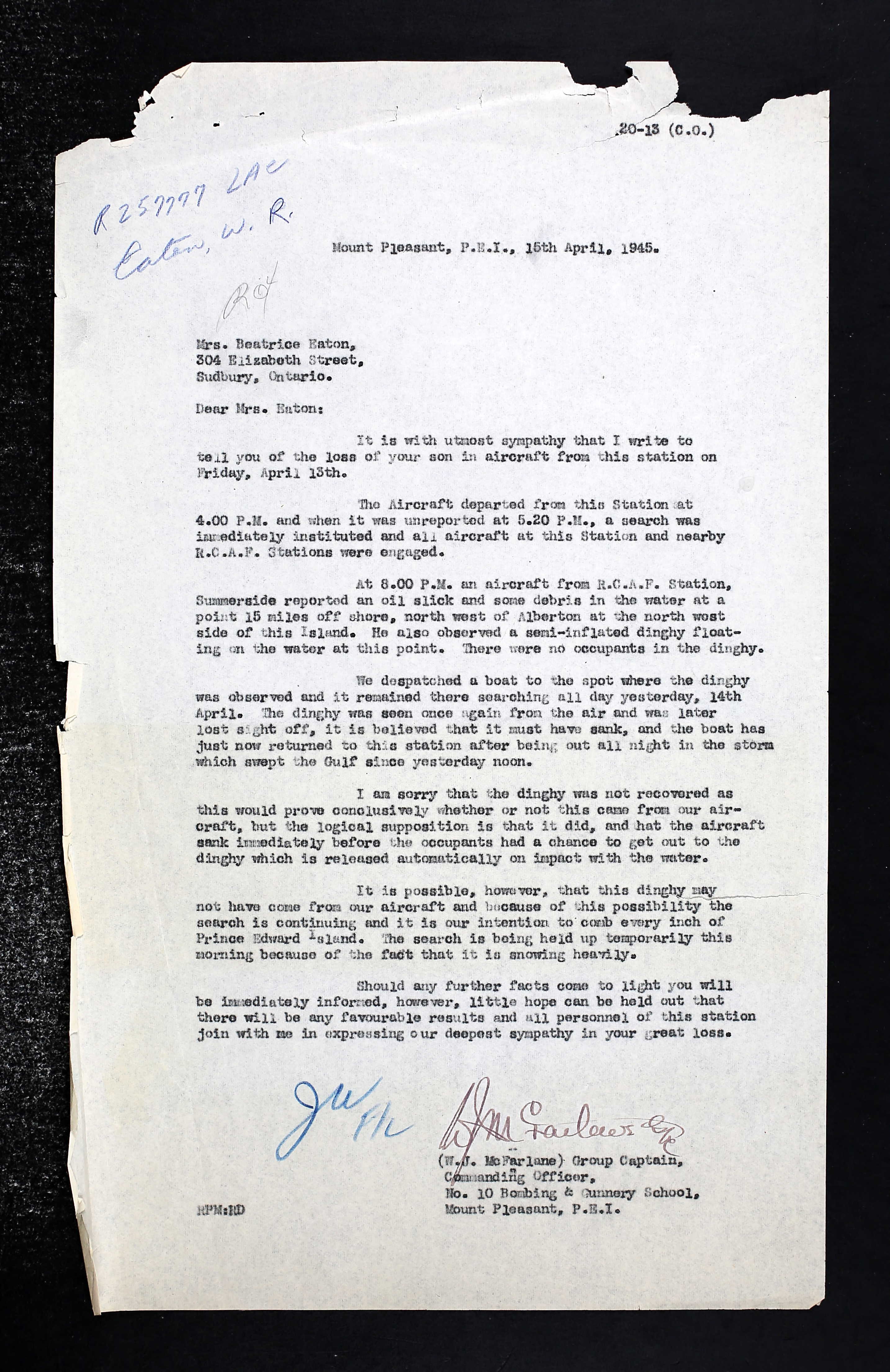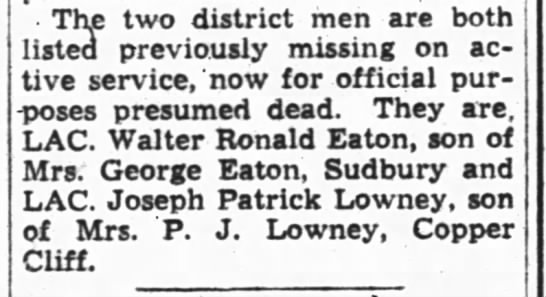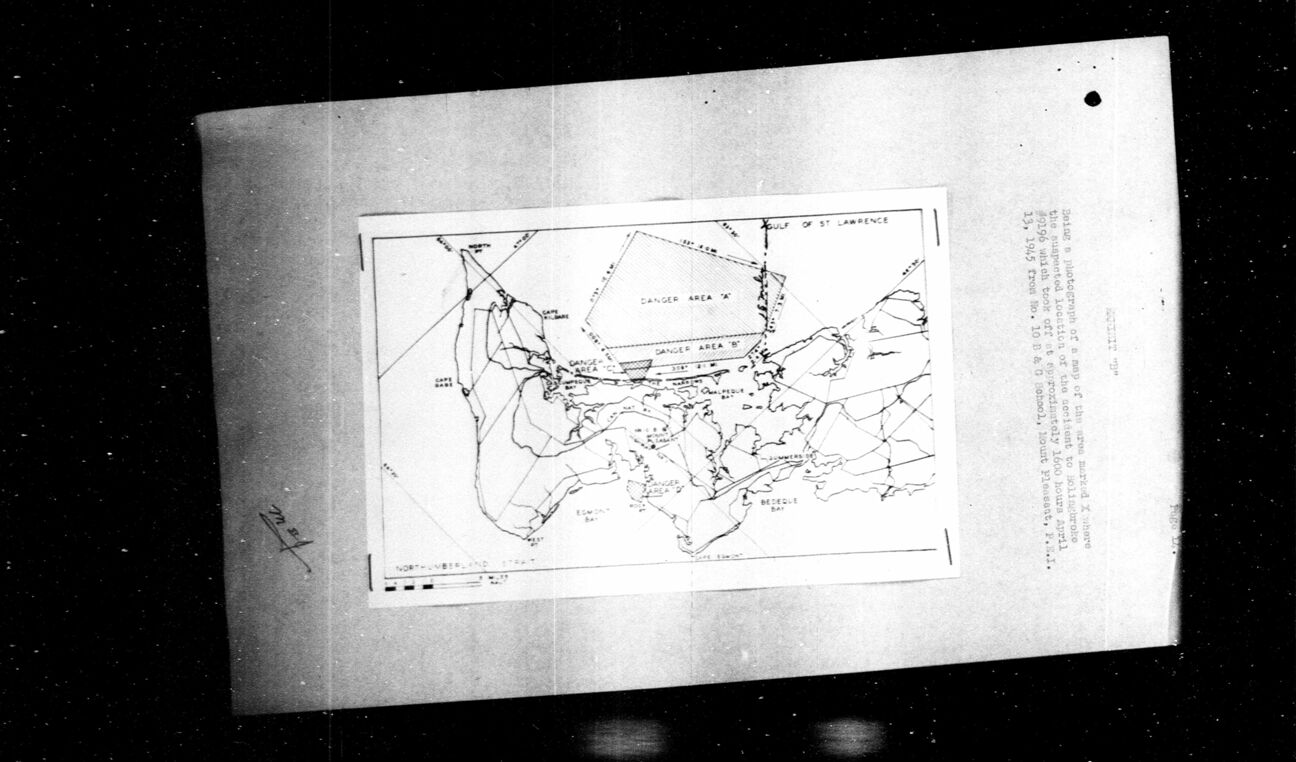



September 2, 1926 - April 13, 1945




Walter Ronald Eaton was the only child of George Frederick Eaton (d. 1943), station agent, and Beatrice Lillian (nee Quesnel) Eaton of Sudbury, Ontario. They were Roman Catholic.
Known as Ronald, he lived in Sudbury, the Lorrainville, then Ottawa, before returning to Sudbury before enlisting with the RCAF at the age of 17 ½ in North Bay, Ontario in June 1943. He stood 5’7 ½” tall and weighed 130 pounds. He was a CPR, assistant agent. “1 ½ years tech. 1 ½ years high school. Fair in maths. Health record good. Unit aircrew because of vision although he really wants it. Assistant agent with CPR. Has a good ear for music. Good physique. A youngster who wants to serve. Looks as if he would make good potential for WOG. Is very interested in telegraphy. Likely type of chap. Seems to know what he wants.” He noted his birth year as 1925, making him one year older. He had blue eyes and brown hair.
Ronald liked football and softball, with five hours as a passenger flying.
Ronald was at No. 5 Manning Depot, Lachine, Quebec June 28, 1943. He was sent to No. 1 B&G Station, Mount Pleasant, PEI, July 22, 1943. He was at the station hospital April 24 to May 1, 1944 and again November 12 - 24, 1944. While at Mount Pleasant, January 19, 1944, he was AWL from 0800 hours to 2200 hours, absent for three days, 14 hours and 20 minutes. He was admonished. He forfeited four days’ pay.
He sent his mother $100/month prior to his enlistment.
Walter was missing from Mount Pleasant, PEI, April 13, 1945, during a gunnery exercise, target towing/drogue flight aboard Bolingbroke 9196 off the coast of PEI.
Mrs. Eaton received a letter April 15, 1945: “It is with utmost sympathy that I write to tell you of the loss of your son in aircraft from this station on Friday, April 13th. The aircraft departed from this station at 4 pm and when it was unreported at 5:20 pm, a search was immediately instituted and all aircraft at this station and nearby RCAF Stations were engaged. At 8 pm, an aircraft from RCAF Station, Summerside, reported an oil slick and some debris in the water at a point 15 miles off short, northwest of Alberton at the north west side of this island. He also observed a semi-inflated dinghy floating on the water at this point. There were no occupants in the dinghy. We despatched a boat to the spot where the dinghy was observed and it remained there searching all day yesterday, 14th April. The dinghy was seen once again from the air and was later lost sight off, it is believed that is must have sank, and the boat has just now returned to this station after being out all night in the storm which swept the Gulf since yesterday noon. I am sorry that the dinghy was not recovered as this would prove conclusively whether or not this came from our aircraft, but the logical supposition is that it did, and that the aircraft sunk immediately before the occupants had a chance to get out to the dinghy which is released automatically on impact with the water. It is possible, however, that this dinghy may not have come from our aircraft and because of this possibility, the search is continuing and it is our intention to comb every inch of Prince Edward Island. The search is being held up temporarily this morning because of the fact that it is snowing heavily. Should any further facts come to light, you will be immediately informed, little hope can be held out that there will be any favourable results and all personnel of this station join with me in expressing our deepest sympathy in your great loss.”
A court of inquiry was called and six witnesses were called. [Microfiche T12353, image 5646] F/S John Alexander Thomson, pilot, LAC Walter Ronald Eaton, drogue operator, LAC Harold Ferguson McBride, drogue operator, and LAC Joseph Patrick Lowney, armourer, were all missing. “Staff Pilot Thomson total flying time 524.35 hours. Time on type: 277.35 hrs. His F/C stated that his flying ability was ‘above average’ and that he had no bad flying habits. DESCRIPTION OF FLIGHT: The aircraft took off at 1600 hours on the flight which had been authorized for routine drogue towing some time earlier and before an instruction had been issued by the I.I. that dispatch was to stop at 1600 hours. At this time, the Control Officer on duty saw two aircraft starting up but neither of these aircraft asked for take-off clearance nor was identified by the Tower. At 1720 hours, the aircraft, which had not been heard of or seen since take-off, was reported overdue and a search was begun for it. Before dark, an oil slick and a deflated dinghy was spotted in the gulf fifteen miles off Cape Aylesbury, 25 miles NE of base. There were small pieces of wreckage floating in the oil slick, but there was no other sign of an aircraft or its passengers. A report of this discovery could not be transmitted by the pilot who made it, because the radio in his aircraft was unserviceable and consequently it was not until he returned to base at dark that he was able to relate what he had seen. The search was continued the following morning by aircraft and by a party in a poorly equipped boat secured from a civilian. The dinghy was located again from the air but there was a heavy sea rolling and before it could be reached the dinghy had sunk and disappeared. The aircraft and its occupants are still missing.
FINDINGS OF INVESTIGATION: Cause: unknown. RECOMMENDATIONS: 1. Crash boat on duty when operations over water are in progress. 2. Dinghy practice and lectures be instituted immediately. 3. That a training flight be established in which a definite programme is set up similar to other units to include regular schedules of instruction on link, all instrument practices and clear hood checks. CONCLUSIONS OF AIB: Aircraft missing. NOTE 1: Two of the missing airmen, LAC Lowney and LAC Eaton went on the flight without the authorization or knowledge of the OC, the Flight who signed the F.17. This officer stated that the names of Lowney and Eaton had been inserted on the F.17 after he had initialed it as authorizing Officer. On May 2, 1945, an unauthorized airman passenger was one of the persons killed in the crash of Bolingbroke 10098 from this same unit. NOTE 2: The F.17 on which the flight was recorded did not have Column B (time to take-off) nor Column 9 (duration of flight) filled in for the subject flight, or any of the flights shown thereon except one. NOTE 3: There was evidence that the pilots at this unit did not customarily wear Mae West. NOTE 4: Dinghy drill was not held at the Unit. NOTE 5: At the time of this accident, the crash boats of the Unit’s Marine Section had not been made ready for service. There were no tradesmen on strength of the unit to do this work or to operate the boats. NOTE 6: While it appeared in evidence that it was the practice for Drogue Flight aircraft to check their radios on the ground and get clearance before take-off, there was no written order requiring this procedure to be followed. NOTE 7: After the investigation, the AOC, No. 1 Air Command visited the Unit to inquire into the matters related by this investigation and referred to above. The CO’s reply to questions raised by the AOC are contained in Appendix B to the proceedings of the investigation.”
The first witness, Flying Officer Arthur Edward McKenna, J29629, O/C Drogue Flight at No. 10 B&G School, Mount Pleasant, PEI: stated that “this was a drogue exercise being a gunnery exercise where in an aircraft from that flight fires on the drogue towed by an aircraft from drogue flight. It is usual for Despatch Flight to phone the drogue flight and request a number of aircraft from them for whatever number of lines they require. I was in the air at the time and I am not conversant with the exact nature of the request. The normal crew for a drogue ship is pilot and drogue operator. I presume the extra passengers carried were given an familiarization flight. It is customary if the men make the request and have proper consent, and that would be O/C Flying, Chief Instructor, of the Flight Commander. The aircraft has a dinghy and the crew should wear ‘wests’ the aircraft is radio equipped and has signal flares. This unit does not have dinghy drill. Normally, there is a crash launch in attendance when exercises are over water, but on this occasion, it has not yet been put into service owing to the early spring. Gunnery crews are briefed on their exercises and my pilot and crew are not briefed as they carry out a definite procedure for every type of exercise. I’ve know F/S Thomson for nine months. He was quiet and reserved and on several occasions, has shown his ability to be an above average pilot. I do not know of him having any bad habits, either personal or in flying. He was definitely not a ‘show off’ but was popular and mixed will in the flight.”
The second witness, Flying Officer, T. Albert Alexander, J25251, staff pilot, No. 1 R and NS, Summerside, PEI: “On Friday evening, April 13th 1945, night flying at the above unit having been washed out, a number of pilots were sitting around the mess when the call came through for four night flying pilots. I volunteered and discovered it was a search for a missing aircraft from No. 10 B&G School, Mount Pleasant, Prince Edward Island. Arrangements were made in flying control whereby the pilots would set course at Cape Aylesbury on a true track a 45 degrees until intervals of four miles had been reached, then alter course to a true track of 315 degrees. I was piloted #4 aircraft and was airborne from base at 1935 hours. My second pilot sighted something about one or two miles straight ahead approximately 12 to 15 hour miles out of Cape Aylesbury. I had been flying at 500 feet and immediately let down to 100 feet. 1/5 aircraft had joined the search and was about two miles from me on my starboard side. I immediately fired two red flares to attract his attention but he did not see me. Appan nearing the object on the water, we discovered it was a yellow dinghy which was unoccupied. In my opinion, the dinghy appeared to be practically deflated. I dropped several flame floats to mark the position of the D then increased my circles to find any other evidence on the crash and discovered an oil slick composed of three or four long patches. This I would estimate to be four or 500 yards long on the windward side of the dinghy. Very small pieces of wood or wreckage could be seen floating in the oil. No other evidence could be found so I returned to the dinghy, climbed to 1000 feet and tried to attract the other aircraft by firing red flares. Unfortunately, my radio was unservicable and I could not contact base or the other aircraft. During the evening search, the sea was very common at the time of my takeoff, the weather was if I recall correctly, light overcast but visibility was very good. A light sea breeze was blowing all during the search. After approximately 40 minutes of circling the dinghy, it was getting almost too dark to see the dinghy and there was no hope of getting any other aircraft on the scene of this accident, so I returned to base and reported what I had found. The following morning, the dinghy could not be found so I requested to see if I could locate it again. I was airborne at 11:10 hours and again flew the same track as the previous night, canceling drift. After six and a half minutes on this track at about 120 mph, IAS, I discovered the dinghy just off my port wingtip. The wind was very strong at about 235/30K. Quite a heavy sea was running therefore I had difficulty in keeping the dinghy insight. I dispatched a message to base by W. T. Giving approximate position and tried to contact the other aircraft that was with me on the search by R. T. But was unable to do so. I then proceeded to mark the position of the dinghy again with flame floats and in doing so, flew very low over the dinghy and have three or four very good looks at the dinghy. The dinghy, in my opinion, was definitely deflated and there appeared to be dried salt on the bottom of it, which later I found to be talcum powder. My information came from observing same type of dinghy at the dinghy room at No. 10 B&G School… I believe the dinghy could have gone under. Previous to my takeoff, a small boat had been dispatched to try to pick up the dinghy. Our only method of contact with same was by Aldis lamp… I was running short of gasoline after three hours and 55 minutes. After half an hour on the ground, I was airborne again at 1510 hours and repeated the whole procedure carrying out every type of search imaginable, but was unable to locate the dinghy, so again returned to base being airborne this flight 2 hours 30 minutes.”
The third witness, Pilot Officer L. Phillp Adam, J886_7, dispatcher in Gunnery Flight, No. 10 B&G School: my duties as a dispatcher, in cooperation with drug flight, I arrange for pilots and students of gunnery flight to carry out certain exercises for which they have already been briefed in accordance with the number of aircraft available from drogue flight and gunnery flight. Drogue pilots take off and when these aircraft are seen to take off, I send off gunnery crews for certain specific exercises. We had no exercises scheduled for 1600 hours or after. There was no permission asked at our flight that Lac Lowney be permitted to accompany a drogue aircraft as passenger. The weather was light winds and very light fleecy cloud at a greater height than the 2500 feet at which any exercises are normally carried out, practically CAVU.”
The fourth witness, Flying Officer J. Bennett McLaughlin, J46707, Control Officer at No. 10 B&G School: “on April 13th 1945 at about 1720 hours, I reported to the O/C flying that Bolingbrook 9196 was overdue and on checking with ‘midway,’ the name of our radio room, ascertained that no R. T. message had been received from the above aircraft. I did not see the aircraft takeoff nor the position of the occupants in the said aircraft. Following the reporting of this aircraft as missing, the procedures as laid down was followed by an endeavour to ascertain its whereabouts. On actual drogue exercises, aircraft are not to take off if the radio is une serviceable. When at 1600 hours I saw two drone aircraft starting up and not being aware of the number of these aircraft, I called Drogue Flight over the PA system and asked her reason for these two aircraft starting their takeoff. The reply was that one was going up on circuits end bumps and that a gunnery aircraft was waiting on the range for the other period not knowing the number of these aircraft, I unable to state whether Bolingbrook 9196 was either of these two aircraft.”
The fifth witness, Wing Commander Guy Vadboncoeur (1909-2007), C715, Chief Instructor, No. 10 B&G: “on April 13th, 1945 at approximately 1540 hours, pilot Thompson was authorized by flying officer fohn, OC drogue flight to carry out a drogue exercise in Bolingbrook 9196. Flight Sergeant Thomson took off at 1600 hours without contacting the control tower by radio, carrying within two drogue operators namely LACs Eaton and McBride, and an armorer LAC Lowney. Flight Sergeant Thompson did not report any exercises complete nor is he reported to have steamed a drogue. He was not in radio contact with the control tower at anytime. At 1720 hours he was reported overdue to me… immediately a search of the island was organized, the Harvard, 1 Anson, and for Bolingbrook being sent out…. Summerside and Charlottetown RCAF schools were notified and five answers were dispatched from Summerside to search an area along the North Shore of P. E. I. Had approximately 2000 hours one of the pilots from Summerside saw a dinghy practically deflated, a small amount of wreckage and oil slick on the water…. The extra two passengers in Bolingbroke aircraft 9196 cannot be explained by the undersigned as the OC C and has instructions not to carry passengers and rogue aircraft. If they have carried out this practice, it is against any instructions. One extra drogue operator however may be carried on a familiarization trip in order to brief him on the work or procedure which is to be carried out for the streaming drogues… it would appear that it is the practice in drogue flight to authorize more than one flight prior to the actual dispatch of these aircraft. It is not the proper procedure as these aircraft must be authorized just before taking off. However on the afternoon in question, instructions were given by the undersigned that dispatch was to be stopped at 1600 hours due to the fact that the training program was well in advance of schedule. Unfortunately Flight Sergeant Thompson took it upon himself to take off on a flight authorized sometime prior to departure. Contrary to instructions, he did not check his radio or report to the control tower by RT with the consequences that if this practice had been carried out according to instructions, he would have been immediately recalled and their loss would not have occurred.”
The sixth witness, F/O Harry F. Fase OC Drogue Flight, No. 10 B&G School, gave his testimony after he returned from leave. “These are my initials on the F-17 authorizing the flight. I did not see the aircraft take off. I received information at 1615 hours that no more gunnery exercises were to take off. I had left the flight at about 1530 hours after making the usual arrangements to keep a drogue ship in the air available for normal gunnery exercises. My reason for leaving the flight was that it was anticipated that I pilot Wing Commander Vadboncouer and the CO to Mont Joli, QC. In the morning, the gunnery flight phone over to drogue flight and advise us that a certain number of drogue ships aren't required. We work out the necessary numbers of our drogue ships that are to be on the line and when the exercises completed, the drogue pilot sends an RT message ‘exercise completed’ and gunnery flight send up another aircraft to carry on. It does not necessarily follow that an aircraft taking off on an exercise uses the drogue ship on the line but may pick up one on the rendezvous. There is not a definite allocation by number of one gunnery aircraft to use a specific drogue ship. The instructions regarding drogue aircraft notifying ‘midway’ Aunt a cough is that and artecoll to make sure radio is working is sent while the drogue ship is on the tarmac but I do not know if this is laid down as a specific order. Aircraft are not recalled from taking off on this unit because they have not cleared with the tower. I do not know of any order to the effect wearing of Mae West's although the students always wear them but I know I am correct in saying that seldom does a pilot wear one. There is no practical dinghy drill but since the new year I recall one lecture to the pilots only. The drogue operators do not receive any nor am I aware of any to the pilots. The crash boat was not in attendance as it was on its way to Charlottetown. Passenger Lowney did not obtain any permission to accompany the flight from us. if a mechanic who has been working on an aircraft wishes to go up, I believe it is laid down in a previous order that he is to be encouraged to fill an unoccupied seat on the flight. If an outsider wishes to go as an excess passenger, I personally require a chit that he has been given permission by either the OC Flying or his flight commander authorizing him to proceed. If an extra drogue operator wishes to go up to familiarize himself with the operation of streaming drogues etc we do not deter him from doing so. At this point I wish to point out that on the F.17 when I authorize the flight the only names authorized by me were Thompson and Eaton, the other two names McBride and Lowney were added subsequently. I normally do not object to them adding a drogue operator. I do not know who made this alteration on the F.17. Since I act as drogue pilot myself and I'm not always on the ground, the program is authorized and not necessarily the flights individually. Actually, I normally authorized two or three flights at a time. All staff pilots receive at least two hours link a month but swing to the lack of instructor recently, no hood or instrument practices have been laid down. Only if the pilot is keen and wishes to do some practice under mutual instruction while they are on 48s is any training practice effected. Either the pilot’s radio did not work and he took off away or knowing that there was no gunnery exercises to be carried out, he wished to go for a joy ride. In the later event if he had called in to ‘midway,’ he would have likely been recalled which he would like to avoid. This is all only a surmise on my part.” When asked if Thomson might have the temperament to indulge in some low flying, Fase replied, “only a thin wall separating my office from the flight room makes it quite easy for me to hear the ordinary flight room chatter. It is my opinion that although the individual pilots are not caught out when blowing off steam, my candid opinion of this pilot is that he may have been indulging in a little bit of unauthorized low flying. Flying discipline as a whole is quite good on this unit. It is very seldom that aerodrome control find it necessary to criticize or check up on poor airmanship. I have no criticism to make of maintenance as they really slug away on their job.”
On May 30, 1945, “the evidence obtained in this investigation discloses a very poor standard of flying discipline at this unit but as you will see the AOC made a personal visit to the station and it appears that the matter is now under control."
In late October 1955, Mrs. Eaton received a letter informing her that since Walter had no known grave, his name would appear on the Ottawa Memorial.